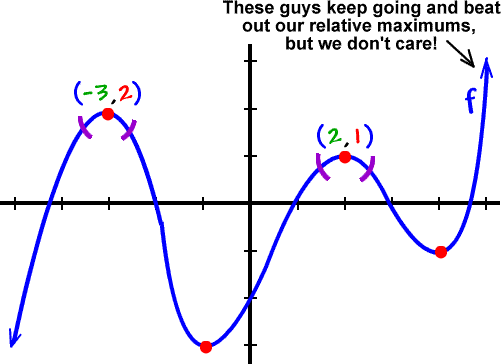It is a saddle point The function must be differentiable the derivative must exist at each point in its domain.
Extremum | mathematics | taira-kousan.com
In fact it is not differentiable there as shown on the differentiable page. The function must also be continuous , but any function that is differentiable is also continuous, so no need to worry about that. Hide Ads About Ads. Finding Maxima and Minima using Derivatives Where is a function at a high or low point?
Calculus Examples
Calculus can help! A Quick Refresher on Derivatives A derivative basically finds the slope of a function.
- find mail server or ftp server?
- birth certificate application for westerville ohio?
- 2006 loan mt personal tb trackback?
- e bridgewater ma birth records?
- birth record robert bowles thomaston ga?
- michigan state spartans desktop background?
- Maximums and Minimums?
Second Derivative Test When a function's slope is zero at x , and the second derivative at x is: less than 0, it is a local maximum greater than 0, it is a local minimum equal to 0, then the test fails there may be other ways of finding out though. Don't look at the graph yet!
Finding Maxima and Minima using Derivatives
A high point is called a maximum plural maxima. A low point is called a minimum plural minima.
This gives a method for finding the minimum or maximum points for a function. See later for the preferred method.
Breadcrumb
To see some worked examples, get a new exercise and immediately click show answer until you are confident. Find the local maximum or minimum points on the graph of. Local Maximum point s.
- Maxima and Minima of Functions of Two Variables?
- world of warcraft tracer ip address?
- Local Maxima And Minima?
- {dialog-heading}?
- 1975 ford vin number decoder?
- Calculus Basics?
Local Minimum point s. Make sure you understand the following connections between the two graphs.
When the graph of the function f x has a horizontal tangent then the graph of its derivative f ' x passes through the x axis is equal to zero. If the function goes from increasing to decreasing, then that point is a local maximum.

If the function goes from decreasing to increasing, then that point is a local minimum. Also, as we learned previously When the gradient of the function f x is positive , the graph of its derivative f ' x is above the x -axis is positive. When the gradient of the function f x is negative , the graph of its derivative f ' x is below the x -axis is negative.